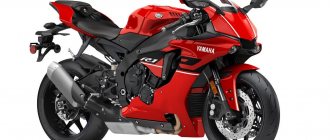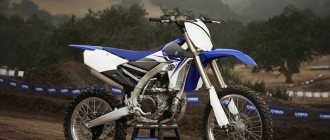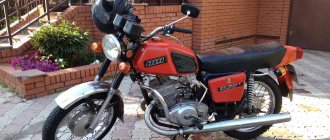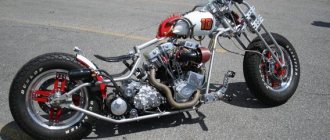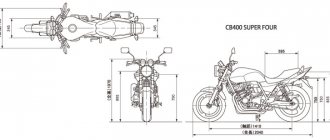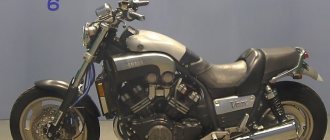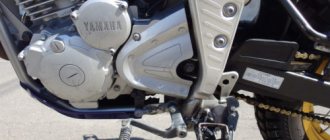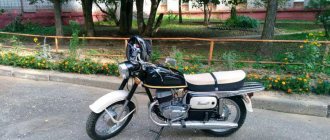Japanese motorcyclesYamaha motorcycles
If this bike were an icon, then before writing about it, you should ask for a blessing. Because the Yamaha YZF R1 is truly a legendary machine. Such tales are born to amaze the imagination, take away peace, break records and change destinies.
Well, as a substitute for a blessing, let’s touch the gas tank with our palm, pick up some dirt from the wheel and rub it over our palm.
He is beautiful! Everything - from the sharp “pike” muzzle to the fervently upturned tail - R1 seems to be declaring: “I’ll break all records like Tuzik a hot water bottle!”
And it’s vomiting! World championships, national championships: France, Spain, Germany, England...
Motorcycle review. The bike is not for dummies.
This is a racing motorcycle designed for the track, for speed and only speed. With its sharp nose and light tail, the Erka resembles a space object, however, the bike can be identified even from afar and against the sun - Yamaha has remained true to itself. However, unlike the previous model: “hard”, brutal, the 2012 bike turned out to be more “sleek”.
The first thing that catches your eye is the seat. It is placed quite high, while other sportbikes have it lower. In reality, this gives additional opportunities to control one’s own body. Its tilt changes the trajectory and helps you take turns more accurately. True, this feature of the bike can play a cruel joke on a non-professional... But the Erka is not a machine for dummies...
Absolutely not for dummies! The bike reacts to the throttle not even like a dog that has finally been let off the chain, but like a projectile that was fired from a catapult - a hundred from first gear is normal. The maximum speed of the Yamaha R1 is 300 km/h!
It is clear that with such agility, the braking system must be very competent. “Special thanks to the designers” for it - on the track it works extremely effectively, providing safe braking at any speed: on a sharp turn after a straight section this is a big bonus for the racer.
In general, turns are the “strong point” of this bike, and the aluminum diagonal frame plays a significant role in this. It is light and, at the same time, tough. When cornering, when the suspension can no longer cope, it is the frame that takes the main load. This one does the job, while at the same time providing the bike with absolutely incredible handling.
Another pleasant point is the smooth gear shift without sudden jerks . At speeds that the motorcycle is capable of reaching - up to 300 km/h, this feature not only saves time, it can save lives. For comparison, the maximum speed of the Yamaha R6 is 265 km/h.
Of course, there is no question of any comfort here. The extremely stiff suspension will make you literally “feel” the track with your whole body. But the rider must feel the track!
Another very interesting motorcycle from the land of the rising sun: the Honda CBR600RR, the technical characteristics of which will appeal to many motorsport connoisseurs.
Do you want your children to engage in motorsports? We can help you decide on the choice of a children's gasoline motorcycle.
MY MOTORCYCLE
At the end of the last century, namely in the mid-90s, Japanese motorcycle designers decided, as they say, to take a break - to stop the frantic race of technical weapons for a while, calm down, comprehend the current situation, evaluate their own strengths, capabilities and prospects. It was then that it was decided to change the main emphasis in the model policy and move from a massive offensive on all fronts to selective, but more powerful strikes. As for Yamaha, it chose the sportbike class as its priority, which became the main consumer of its technology and finances for the next two five-year plans. And the fact that the money was not wasted is evidenced by the triumphant success of the new YZF series road rockets, which debuted in 1997. The flagship of the line all these years has been the famous R1 - the “first era”, as its fans lovingly call the model.
Over the years, the R1 has undergone several major upgrades, not counting almost annual restyling. Radical processing dates back to 2004, and in 2006 the company limited itself to additional “fat burning” and a small increase in horsepower (three more horsepower - 175 hp). The engine was tilted forward a little more, up to 40° from the vertical. The bore-to-stroke ratio has been reduced to 77 x 53.6 mm, which shifts peak power to an even higher rpm zone. By increasing the rake of the powertrain, the Deltabox frame members extend from the steering column directly to the box mounting location above the cylinder heads, rather than around the block. As a result, the frame narrowed at the pilot's seating position. In addition, it is lighter and stiffer. By racing standards, the chassis geometry is somewhat conservative, but by all measures it is clear that with a minimum of modifications the motorcycle has improved maneuverability.
All this indicated that the debut of the radical version of R1 was deliberately delayed. After all, frequent handouts can spoil the most sophisticated aesthetes of motorcycles - sport bikers. In turn, the latter, perhaps, would have suffered another season or two, if not for the big date - the 50th anniversary of Yamaha. In such circumstances, the manufacturer is simply obliged to please the clientele with valuable gifts. One of them was the YZF-R1 Special (SP) version, almost ready for racing. Despite the cost of almost $25,000, the release will exceed 1,000 copies. The circulation is, of course, small compared to the serial one, but relative to the limited series of racing replicas it is very decent. Typically, the circulation of such purely sports models is a maximum of two to three hundred pieces.
Yamaha thereby killed two birds with one stone. Firstly, it gave those hungry for an exclusive a greater chance of purchasing it. And secondly, this is exactly the volume of production required for the car to participate in the European Superstock championship - very popular and effective in terms of promoting a particular model. The calculation is simple to the point of banality: the device will probably be bought not only by collectors of sports rarities, but also by ordinary athletes. After all, it does not require any tuning injections. All the rider needs are lightweight Marchesini wheels, a slipper clutch, a suspension height adjustment mechanism and the fully customizable Ohlins suspensions themselves. All this is included in the basic package. In addition, the SP version has a completely different chassis geometry compared to the regular Erka. The front fork crossbars are of a new shape, the fork settings are much stiffer, and even the front “shifter” pipes are different – the outer ones are thinner, the inner ones are thicker. By playing with these chassis parameters, the designers were able to make the motorcycle more responsive to the pilot’s actions. Well, for better stability and for more complete use of motor forces, the base was increased due to an elongated (20 mm) rear pendulum. As a result, the weight distribution has changed (the current proportion is 52/48), that is, there is much less weight on the front end. A sports motorcycle that is homologated for public roads is still at least 90% a track machine. That’s why you shouldn’t expect the YZF-R1 SP to provide the comfort of a sports tourist or the maneuverability of a road warrior. It even has tires from Pirelli, rather than the usual Michelin ones. On summer asphalt, the softness and stickiness of the former will ensure much faster wear compared to the latter, but on a wet road the Pirelli are much better at draining water from under the tread. This is the type of tire that many Superstock racers use in the rain. And on an ordinary road, it will allow you to enjoy the delightful feeling of complete power over the car. Supported by powerful braking systems, these tires simply bite into the asphalt.
Let's talk a little about the brakes. There are two 320mm discs at the front and a single 220mm disc at the rear, plus excellent radial brake calipers from Sumitomo. In fact, it is one of the most high-tech braking systems on the planet. It doesn't have the extraordinary initial bite of class-leading Brembo, but it responds more predictably, requires less lever travel, and has almost perfectly linear modulation. The new control computer setup and dual throttle valve assembly (with an electronic position sensor) allow for very precise throttle dosing, making the most of the characteristic curve, which, according to Yamaha comments, has become smoother, with no extreme dips or surges. However, the power of the liter engine was increased to 175 hp. with a device weight of 171 kg! Moreover, the maximum torque indicator is also outstanding - 107 Nm! Almost like a 1500 cc custom. The stock air intakes are located under the “eyes” of the light optics - not the best place for the ideal functioning of the standard inertial charging system. The intake holes are moved too far from the “peak” of the fairing, which is where the maximum air pressure occurs during movement. In theory, the “face” of the SP should have been “sculpted” in a completely different way. However, you don’t pay attention to all this while driving. Fortunately, the seat was made surprisingly comfortable, and there was even a seat and footrests for the passenger. Nothing less than a bonus for the future owner who wants to reduce dry weight. As a rule, such cars are made single-seater.
At speeds under 300 km/h, the motorcycle is stable thanks to the long rear swingarm and careful adjustment of the stock Soqi steering damper. However, it is worth saying that even on the SP the windshield is too low for such high speeds. If you don't lie down on the carbon fiber gas tank, the air flow will hit you right in the face. Moreover, after 150 km/h you have to painfully strain your neck. The first thing racers do when preparing an R1 for the track is install a taller windshield. You are mistaken if you think that such a device can be used to prance along the capital’s avenues. Ergonomics and landing immediately put the pilot in a racing mood. The most comfortable option is the fetal position, when there is only a windshield in front of your face, and your eyes are directed only to the dashboard. By the way, the analog tachometer dominates there, which displays amazing crankshaft rotation modes. So, the red zone starts at 13,800 rpm, which is the correct number. Any speed below is at your disposal. The liquid crystal speedometer, on the contrary, is as if in the shadow - to the left and in the depths. Probably so that the neophyte pilot would not have a heart attack out of habit when reading the instrument readings. But the lap counter (it starts when the starter button is pressed during races) is a purely sports option. In general, the “tidy” on the SP in terms of functionality is much better than that of the regular R1. For example, you can choose the color of the gear shift sensor. And the backlighting of liquid crystal displays is done correctly. Devices should help control the car, not distract. The new electronic injection system with two-valve throttle valves and additional valves controlled by an electric motor operates smoothly, without jerking or the “slamming door” effect. The throttle reacts clearly and almost instantly in the range from 2400 rpm to the red zone. A noticeable surge in power occurs at approximately 5000 rpm. Then, after 8,000 rpm, the power curve suddenly peaks, the airbox begins to howl, and the bike flies off into the horizon.
and in a straight line, the Yamaha YZF-R1 SP turns into a meteor, but it can only scare you when cornering. However, the power delivery is very smart, and the rear tire won't lose weight unless you want it to. Yamaha designers have created an amazingly stable platform with excellent on-road performance. The front end shakes only when you engage the overdrive gears at full throttle. The suspension is a little harsh for the street, but the front of the car holds the road stably, and the driver is confident that the front wheel will always go where it is directed. The suspension absorbs a lot of road imperfections, especially at low speeds when the rider's weight is distributed with more emphasis on the arms. The motorcycle can be easily controlled in rush hour traffic, but landing puts a strain on the pilot's hands, and they will soon begin to ache if the person is not used to riding sportbikes.
Technical characteristics of Yamaha P1
| Manufacturer | Japan |
| Dry weight | 170 kg |
| Curb weight | 206 kg |
| Ground clearance | 136 cm |
| Tank | 18 l |
| Engine capacity | 998 cm3 |
| Engine Configuration | in-line |
| Bars | 4 |
| Cylinders | 4 |
| Valves per cylinder | 4 |
| Power (max) | 182 hp, 12500 rpm |
| Torque (max) | 115.5 N•m, 10000 rpm |
| Inlet | injector |
| Cooling | liquid |
| Launch | electric starter |
| Manufacturer's recommended fuel | AI – 95 |
| Transmission | mechanics, 6 gears |
| main gear | chain |
| Clutch | multi-disc |
| Frame | aluminum |
| Front suspension | inverted telescopic fork, 120 mm travel |
| Rear suspension | pendulum, monoshock absorbers, stroke 120 mm |
| Front brake | hydraulic double-disc |
| Rear brake | hydraulic disc |
| Tires: Front wheel | 120/70 ZR17 58W |
| Tires: Rear wheel | 190/55 ZR17 75W |
Yamaha R1 2007
There is no point in doing reviews on such motorcycles, because this is a motorcycle for racing. In the racing field, this motorcycle is already well known. Therefore, this review contains more analysis of interesting facts and emotions.
In world journalism, the term “hot spot” is often used to denote a territory with a prolonged armed conflict. In the motorcycle industry there are also such points, and with very specific coordinates - for example, “height 1000” is 1000 “cubes” of the working volume of a sportbike engine.
Here the developers are ready to jump out of their pants to show something extraordinary. And one of the main topics among motorcyclists is “liter” road bikes. This is some kind of magical threshold, up to which everything is simply frivolous, and beyond that it’s too much. It is not surprising that manufacturers are trying to stay on this edge, showing miracles of dexterity.
The boyish games of king of the mountain do not stop, there is no end in sight. Moreover, as the example of the latest Yamaha model showed, all methods are good here. It is not at all necessary to put your competitors in their place with the help of the latest blaster - sometimes it is enough to fire over their heads with an old hunting double-barreled shotgun. The effect is the same!
Yamaha's top sportbike has always been distinguished by its excellent power supply. The most lightweight components of the engine components, each time a cunningly inflated frame and an increasingly advanced suspension, the most advanced power system, etc. The “trick” was also the 20-valve “head” of the cylinder block, which the company promoted not only in the sports motorcycle sector, but also in the automobile. And suddenly, in the press release of the newest 2007 YZF-R1, we see some measly 16 valves in a four-cylinder in-line engine!
Simply a betrayal of the ideals of the revolution! It must be said that in the camp of fans of the cult model (popularly known as “erka”), this circumstance caused, to put it mildly, misunderstanding. Why was it necessary to fence the garden all these years? Then to demolish it overnight with a bulldozer? Let's find out...
Any evolution has a limit. At some point, the potential for change is exhausted, development stops, and in order to move on, either external cardinal influences on the object of evolution are needed, or a return to one of the past stages and restarting it in a different direction. This truism was known to Yamaha designers, who had long worked out the 20-valve circuit inside and out. And then there are the new Euro 3 standards. The principle “More fuel mixture - more power” will no longer work. In general, we had to return to the proven 16-valve circuit.
With four valves per cylinder, it is much easier to reduce intake resistance and, in general, tune the engine for the “upper” range, especially with today’s very dense engine layout. In addition, the traditional Yamaha 24-degree valve camber made it possible to greatly straighten the channels, which had a good effect on the intensity of filling the cylinders.
And this despite the fact that the R1 power unit was and remains very short-stroke - 77 x 53.6 mm (for example, the Suzuki GSX-R 1000 - 73.4 x 59 mm). However, the valve diameter is still not the maximum. So, the exhaust ones are 25 mm (the same “liter” GSX-R is 26 mm). There is room for further activity! Be that as it may, the engine reaches 180 horsepower (at 12,500 rpm), captivating for any sport biker, despite all the Euro 3 obstacles!
How? The lifesaver is the electronic throttle. This purely Yamaha know-how was successfully tested on a 600 cc relative of the Erka. Thanks to the miracle throttle, it is possible to achieve adequate, smooth, without unnecessary “bursts” of engine reactions to turning the throttle.
To the electronic throttle, the designers added the YCC-I (Yamaha Chip Controlled Intake) system - also an exclusive Yamaha solution, first used on a production motorcycle. This is an extension of the intake pipes to use the effect of resonant supercharging in a wider range (naturally, a new air filter was built for this purpose, at the same time increasing its volume). With the help of a servomotor that receives commands from the on-board computer (reads the motor parameters 1000 times per second), as the speed increases, additional pipes are disconnected from the main pipes. Their length becomes not 140, but 65 mm! A similar arrangement with pipes of different lengths has been known in motorsport for many years, but only recently have they become directly driven by a servomotor, rather than manually by mechanics. Otherwise, the power unit is almost identical to that installed on the last generation R1 of 2004. True, now they use a “slipper” clutch instead of the usual one.
For a sportbike with such power output, this is now the norm. A distinctive feature of all new cars that meet Euro 3 standards are short silencers of unusual shape. The Yamaha R1 also has a new exhaust system - oval mufflers located in the same place, under the “tail”.
The chassis of the vehicle was developed according to the same principle that the new is a well-thought-out old. It is impossible to find differences in the frame configuration of the new and previous models. However, the press release claims that the wall thickness and configuration have been changed, especially in the motor mounting areas. Let's take his word for it...
But the pendulum is obviously new. The whole thing is somehow asymmetrical. It consists of three parts - two forged and one cast. For what? To increase torsional rigidity (by 30%!), however, to the detriment of lateral rigidity. All this is to improve the motorcycle's cornering behavior. Among other things, the new pendulum made it possible to change the kinematics of the rear suspension and final drive, and to straighten the exhaust system, which is also a plus in terms of aesthetics.
The modernization of the pendulum entailed an upgrade of the rear suspension linkage system. The progressive characteristic has almost doubled – from 8 to 14%. Moreover, the adjustment includes not only “slow” but also “fast” damping. The front 43-mm telescopic fork (not gas-filled!) of an inverted type is completely new, although it looks the same as the previous one. It has completely different stiffness characteristics. The thickness of the fixed pipes has been reduced, and the axle mounts, on the contrary, have become more massive. Thus, elasticity has increased, and the decrease in rigidity is compensated by a lower cross-arm with a thickness of 40 mm - instead of the traditional 25 mm.
The diameter of the brake discs has been reduced by 10 mm to 310 mm, while six-piston brake calipers are installed at the front. This regrouping of forces did not reduce the efficiency of the system (the brakes of the R1 were always excellent), but the rotating masses were reduced.
The appearance of the car, however, remained virtually unchanged. Except that the “tail” has become narrower, and the same with the air intakes. This is like a hint that the new R1 is worthy of the glory of the previous eras, and 16 valves instead of 20 will not spoil the mass. Yamaha has thrown down the gauntlet to its competitors. Who will be the first to accept the challenge?
The birth of a legend. History of the model.
At the time of birth it was the fastest motorcycle on the planet !
Up to a hundred - less than three seconds, and only seven and a half - up to two hundred. However, the bike did not become a “death capsule”, because along with such incredible speed characteristics it received excellent handling, gaining fame as a very “racer-friendly” machine. The designers managed to achieve this: firstly, by moving the bike’s center of gravity as low as possible, and, secondly, by reducing the wheelbase and increasing maneuverability.
The legendary motorcycle is already 16 years old, and during all this time its recognizable appearance has changed, if at all, not too significantly, which means it was successful from the very beginning.
The 2002 Erka differed insignificantly from the first motorcycle: an improved injection system and easy suspension upgrades. The main difference is a new, cast frame with minimal welding, which makes it more rigid.
Two years later, another model appeared, easily recognizable by its front-mounted air intakes. There were no significant changes in the design - the brakes and steering wheel were slightly modernized, equipped with a damper.
And only in 2007, the model range was replenished with a bike with a modified engine with a 4-valve arrangement per combustion chamber. However, the declared 182 “horses” look cool only on the stands. In practice, on the way to the drive wheel, 36 of them run away somewhere...
2009 was marked by the appearance of a number of improvements on the sportbike, designed not to increase speed, make cornering easier, or save a couple of milliseconds on anything else. No! Erka was equipped with several ignition maps for different weather and type of road surface. It seems that for the first time the designers of a crazy sportbike seriously, like adults, were concerned about the safety of the pilot.
The trend continued and in 2012 the Erka arrived with traction control. And here the designers were original: this bike does not have tilt angle sensors. Their function is performed by sensors located on the wheels.
How much does happiness cost? Average price for a motorcycle.
About 800,000 tr.
Given that happiness has no price at all - it’s not expensive, right? Why do you need a car? Four wheels are clearly too much. Sell it. Although, if you don’t go to such extreme extremes, you can surf the net and find a decent Erka at the price of, if not a used Zhiguli, then a new one – easily! On the official website of the motorcycle manufacturer you can find recommended prices and additional accessories.
The author of the article saw with his own eyes an advertisement for the sale of such a bike for 177,000 thousand, however, one can only guess about its condition, a 10 x 10 photo does not give an idea about it, but why not? If such a miracle as the Yamaha YZF R1 appeared in the world, then other miracles must happen.
Domestic motorcycles lag somewhat behind foreign ones in terms of characteristics. For example, the IZH Jupiter 5 motorcycle has a maximum speed of only 125 km/h without a sidecar.
But our snowmobiles are of fairly high quality. In our article we will analyze in detail snowmobiles from.
Motorcycle Yamaha YZF-1000 R1 2004 review
The description of the Yamaha YZF-1000 R1 2004 motorcycle is in the queue for publication of the article. Announcement: Today, for almost every new motorcycle that comes into being, marketers strive to carve out their own niche. This one is a road sport, this one is a recreational enduro. But what class should we include a motorcycle that has a little bit of everything? A good bike should have a reliable engine, comfortable ergonomics and simple controls...
Yamaha YZF-1000 R1 is a motorcycle not sold in Russia, equipped with a very powerful 170 hp engine. Despite the fact that good models of motorcycles have a very respectable price, and the season for their use is relatively short, the motorcycle market is developing rapidly. And if you believe the words of dealers, then some models of recently released motorcycles are selling like hot cakes at the beginning of the season, and the models brought to Russia are clearly not enough to fully satisfy consumer demand.
A motorcycle has long ceased to be an alternative to a car, and the times when this equipment was bought only because there was not enough money for a full-fledged car are forgotten. Nowadays, two-wheelers can be called technological marvels in many cases, and their cost can be compared with that of prestigious cars.
Many people have started buying motorcycles for hobby purposes as riding or even collecting them has become a good pastime for many people. Many motorcycles, for example the Yamaha YZF-1000 R1, whose technical characteristics make it possible to call the model a prestigious brand, are in demand among both beginners and experienced motorcyclists.
Currently, it is impossible to purchase a new Yamaha YZF-1000 R1 motorcycle of the 2004 model year, since their production stopped 12 years ago. At the same time, the Yamaha YZF-1000 R1 has excellent technical characteristics, so many people strive to purchase, if not a new, then at least a used version.
Motorcycles with an engine capacity of 998 cc. see, appeared as a result of long work of inventors who sought to create a model that was not inferior in characteristics to other versions of the motorcycle. In some cases, these models are not only not inferior, but also ahead of other motorcycles, as they have minimal fuel consumption and other excellent parameters.
Motorcycles with an engine capacity of more than 400 kb. cm, which includes the Yamaha YZF-1000 R1 - this category of motorcycles simply cannot claim the title of “motorcycle for a beginner.” On the contrary, this is already a serious technique that requires certain control of motorcycle equipment with a smaller engine capacity. Yes, she attracts more attention, she is the most beautiful, fast, interesting and there is a huge selection of models. But as power increases, the weight of the motorcycle inevitably increases. In this class you are unlikely to find motorcycles lighter than 180 kg, unless they are the latest motorcycle models.
Go to the entire range of Yamaha motorcycles, on this page you can find Yamaha YZF-1000 R1 motorcycles from other years of production and information about them
Photo gallery
From our review you can find out how good this motorcycle is; the photo selection will perfectly complement the image you have formed.
Yamaha YZF-R1 Video
We present to your attention a well-assembled selection of rides on this motorcycle, which well demonstrates all its capabilities.
In the hands of a professional, a motorcycle can do incredible things. And the right music will make viewing even more enjoyable. As one popular character in a Hollywood movie said, “You are either mad or a genius. These are two extremes of the same essence." The hero of the next video clip is just balancing on the brink. Perhaps it would even be possible to publish this video under the hashtag “Dementia and Courage”, if not for the professionalism of this motorcyclist.
In a word, see for yourself, decide for yourself. Carefully! It's breathtaking to watch.
Did you like the article? Tell your friends!
Comments (3)
- liz1990:
03/11/2015 at 03:36In fact, I have always respected this particular motorcycle manufacturer. In my opinion, this company is the most reliable. It produces truly high-quality and durable equipment.
Answer
- Dima:
05/24/2015 at 02:54
I also have enormous confidence in this company)) They really rarely break down. I started with the Joga 50cc, which broke down least often)) Now I ride on the indestructible YBR 125))
Answer
- Dmitriy:
08/15/2016 at 20:13
Ground clearance 136 cm - correct
Answer
